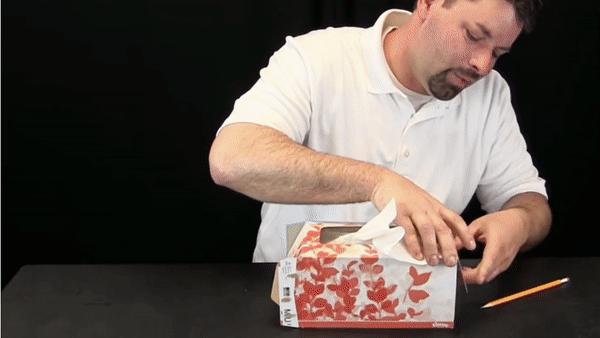
By Jared Hottenstein
In the world of STEM learning, most teachers think about designing, building, and creating. But sometimes the best way to see how something is designed is to pull it apart. I’ve always thought that science dissections were awesome. Many of my students wouldn’t agree. Dissections can get a little gross for a classroom setting. Taking the time to carefully open something up to see what’s going on inside doesn’t have to be limited to once-living things. Why not dissect common objects?
When I was a kid, I loved pulling things apart to see what they looked like inside…television remotes, electric pencil sharpeners, even my mom’s clothing iron. Unfortunately, I was never able to put them back together again. I’ve discovered that carefully pulling apart even simple things like ball point pens, tissue and cereal boxes, and even a Ziploc baggie can be just as interesting and engaging as animal dissections. Think of it as an engineering autopsy!
An engineering autopsy is more than just cutting something apart. It’s strategically taking something apart to discover how it works. It’s a different way to think about STEM learning.
Where to Start:
Elementary school engineering dissections need to be simple. You can’t expect a third grader to disassemble an RC car or helicopter drone and figure out how it works. Start with something basic. Twist ties, tissue boxes, clothes pins, Ziploc baggies, and the folding tops of cereal boxes are simple things most kids already have in the house.
You may think those items are too simple, but most kids have never thought about how they work. Why does a twist tie stay twisted? What’s inside the paper? Why does a new tissue pop up in the tissue box after I pull one out? How does a clothespin work? What makes a Ziploc baggie or cereal box stay closed?
Students don’t need any special equipment for these dissections. A simple pair of scissors works perfectly. It won’t take students long to find a flexible wire inside that twist tie. They’ll quickly see that the tissues are folded in a very specific pattern inside the tissue box. If students look carefully, they’ll discover that springs, clips, and flaps are the reason that clothespins, cereal boxes and more stay closed. Once students learn how an engineered item works, they can try redesigning each item using simple materials.
Next Steps for Dissections:
After students figure out how something works, it’s time to see if they can create their own version of the item they dissected. FunScienceDemos has a few videos that walk you through a few engineering dissections.
Can students use aluminum foil to create a twist tie? If they carefully roll up a small section of aluminum foil, they can create a working twist tie.
Tissue boxes come in many different shapes and sizes. I’ve found that the tissues inside those different boxes are often folded in different ways. Once students learn the folding patterns, they can fold their own tissues and create their own tissue box using different recycled containers. For instance, we made our tissue boxes at FunScienceDemos out of Pringles containers.
Dissecting Ziploc baggies may require some magnification. I’ve found that snapping a picture with my phone and then zooming in on the picture is one of the best ways to see what’s going on with the baggie. You’ll find that a plastic ridge snaps into a narrow groove.
When it comes time for students to make their own Ziploc bag, a sandwich bag and two straws work perfectly. Students will need to slice through one side of a straw with a scissors so that straw can clip over the other straw and clamp the sides of the baggie together.

Here’s the full video:
What about a cereal box?
If you’re going to do an engineering autopsy on a cereal or snack box, I would suggest collecting a variety of food boxes so students have a large sample size from which to choose – along with a healthy supply of cardboard. Fast food and Chinese food containers, plastic fruit or vegetable containers, or any cardboard box that needs to be opened and closed multiple times will work.
Rather than design an entire cereal box, I would suggest engineering a short sleeve that can slip onto the top of the cereal box. That way, students can focus on different methods of closing the cardboard flaps and not worry about creating an entire box. One quick note about cutting cardboard. Corrugated cardboard used in shipping boxes is tricky to cut in the classroom. It’s usually too thick to cut with a scissors. I would suggest sticking with the thin cardboard that’s used to make cereal or food item boxes. I find that having students cut apart an entire cereal box is the way to go.
Here’s a video showing how to proceed:
Next Level Dissections:
Students in middle school or high school can handle more complicated dissections. Clicking pens, wind-up toys, pencil sharpeners, spray bottles, squirt guns, and cheap electronic kids’ toys can be a good place to start. Students at this level may be able to mix and match parts from each toy to create a brand-new item. Maybe they can use the motor from an electronic car to make an electric pencil sharpener! The sky’s the limit.
Market It!
Once your students create their own product, it’s time to package it and advertise. This is a perfect opportunity for your students to showcase some creativity. Can they come up with a new name?
This is also the perfect chance to have some fun. Why not have your students make infomercials for their products to showcase the newly-created item? A good way to end your lessons on engineering dissections would be to watch the students’ infomercials. If you wanted to assign a grade to the work students do on their engineering autopsy, you can always have them draw up an autopsy report for what they pull apart and a blueprint for what they create. If you get your students pulling apart a tissue box, maybe they won’t pull apart the tv remote!



Jared,
With this school year being different than past school years and students participating either remotely or in-person using resources like the tissue box for engineering an autopsy is a great idea. Through reading your post, I was inspired to think outside of the box to use everyday items that can be found in the classroom and at home to help reinforce concepts with students and help them have fun while learning. Thank you for the inspiration to continue helping students regardless of their school setting.
Patrick